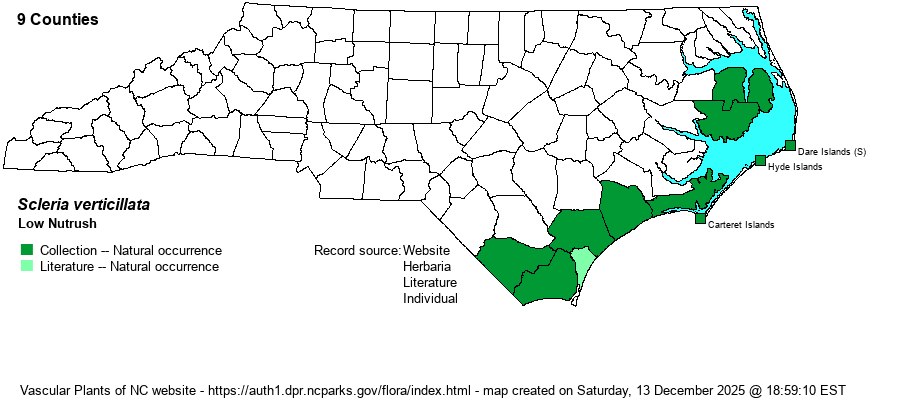| Author | Muhlenberg ex Willdenow | |
| Distribution | Outer Coastal Plain and Outer Banks/barrier islands.
Western MA to southern Ont. and MN, south to southern FL and TX; Bahamas, Cuba. | |
| Abundance | Rare to uncommon; perhaps somewhat overlooked. The NCNHP database contains 24 records, about 20 still extant, and 8 in excellent condition. The website editors suggests a State Rank of S2S3, as it does not quite seem to be as overly rare as S2; this is a Significantly Rare species. In 2020, Alicia Jackson found a number of large populations on marl roadsides in Brunswick County. | |
| Habitat | Maritime wet grasslands, wet Longleaf Pine savannas underlain by coquina limestone, moist roadsides in soil with coquina. Restricted to alkaline conditions. |
| Phenology | Flowering and fruiting July-September. | |
| Identification | This is a small, delicate, annual nutrush, lacking the tough horizontal rhizome of most other nutrushes. It is unique in our nutrushes in its elongate, erect inflorescence of sessile, well-spaced, small spikelets. The leaf sheaths are long-hairy. | |
| Taxonomic Comments | None
The genus Scleria, named as nutrushes, is a group of sedges notable for the white, often glossy, achenes (seeds) and tough, knotty, horizontal rhizomes (absent in S. verticillata, S. muehlenbergii, and S. reticularis). Stems are 1-many per plant, terminated by inflorescences of 1-several spikelets, subtended by leafy bracts. In some species there are also inflorescences produced from upper and middle stem leaf axils, these usually on long arching stalks. A dissecting scope is necessary to examine the achene for shape, ornamentation (bumps, pits, ridges), and hairs. Just as important are features of the hypogonium, upon which the achene tightly sits: present or not, how many lobes, and ornamentation (bumps, sharp points, etc.). | |
| Other Common Name(s) | Savanna Nutrush, Whorled Nutrush | |
| State Rank | S2 [S2S3] | |
| Global Rank | G5 | |
| State Status | SR-P | |
| US Status | | |
| USACE-agcp | OBL link |
| USACE-emp | OBL link |

